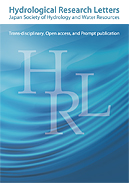All issues

Volume 8 (2014)
- Issue 4 Pages 108-
- Issue 3 Pages 96-
- Issue 2 Pages 77-
- Issue 1 Pages 1-
Predecessor
Volume 8, Issue 3
Displaying 1-2 of 2 articles from this issue
- |<
- <
- 1
- >
- >|
Original Research Letter
-
Masakazu Hashimoto, Tadashi Suetsugi, Yutaka Ichikawa, Kengo Sunada, K ...2014Volume 8Issue 3 Pages 96-102
Published: 2014
Released on J-STAGE: July 26, 2014
JOURNAL FREE ACCESSWe quantitatively investigated the relationship between flood conditions and the incidence of diarrhoea caused by flooding in Dhaka City, Bangladesh, by using a two-dimensional flood simulation model. We performed flooding simulation in target areas, and the simulated results were compared to diarrhoeal morbidity. Diarrhoea causes were assessed through home-visit morbidity surveys; these surveys were conducted three times in different phases of the rainy season (pre, mid and post-monsoon) in 10 low-income communities in flood-prone areas of Dhaka City, targeting children below five years of age. The results revealed that flooding influences the morbidity of diarrhoea, as increased morbidity was identified in almost all communities in the mid-monsoon season. However, cases with a predisposition of diarrhoea such as socioeconomic status were also identified, as morbidity was observed in pre- and post-monsoon seasons when flooding did not occur. Furthermore, morbidity was higher in areas with maximum flooding depth of 0.7–1.2 m than that in areas with maximum flooding depth of 0.1–0.2 m in each season. Consequently, we found that the gradient of diarrhoeal vulnerability is affected by predisposing factors such as socioeconomic status, and its influence is maintained throughout the rainy season.View full abstractDownload PDF (6954K) -
Michiaki Sugita, Hiroya Ikura, Aiko Miyano, Kazuya Yamamoto, Wei Zhong ...2014Volume 8Issue 3 Pages 103-107
Published: 2014
Released on J-STAGE: August 29, 2014
JOURNAL FREE ACCESSEvaporation E from Lake Kasumigaura, the second largest lake in Japan, was estimated continuously at a 3-h interval for the period of 2008–2012 by means of a bulk formulation applied to 23,468 grids covering the whole lake surface. A functional form of the bulk coefficient was determined from eddy correlation measurements at the central part of the lake. Wind speed (U), temperature, humidity, and infrared radiation surface temperature, from which the specific humidity qs of the water surface was determined, were also measured. Specific humidity q and U at 10 m above the surface of each grid were derived from routine measurements at meteorological stations in and around the lake, by applying the Kriging interpolation scheme. This operation produced not only the totals but also the horizontal variation in E. The mean annual E was estimated as 911 (± 42) mm, which is within the range of previous estimates of 671–1003 mm/yr. Seasonally, E followed the change in net radiation with a short (< 1 month) phase delay caused by stored energy in the water body. Year-to-year variation was small. Horizontally E tended to be larger in the central and southern parts of the lake, reflecting stronger wind regime there.View full abstractDownload PDF (2460K)
- |<
- <
- 1
- >
- >|